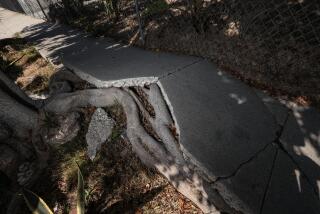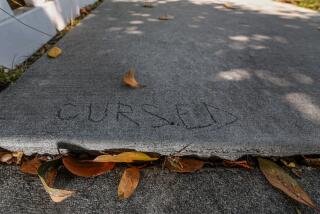Mayoral candidates step into sidewalk debate
Les Butts of Woodland Hills was walking his dog earlier this month, which can be a dangerous activity in a city with nearly 5,000 miles of ruptured sidewalk. Butts, a musical instrument salesman, hit a patch of uneven pavement and took a tumble, falling onto his shoulder and scraping his knee.
“I’m not one to file frivolous lawsuits,” said Butts, whose knee was swollen for more than two weeks. But not everyone is as willing to turn the other cheek in a city where the sidewalks just keep getting worse.
Trees with invasive roots were inappropriately planted by the city adjacent to sidewalks, and they’re not being maintained.
Butts would know about that. He said that in the last year, city trees have crashed onto his house and car. The one that hit the house “screwed up the roof, the chimney, and put a hole in the side of the house,” Butts said.
Every time I check my e-mail, I’ve got similar tales of woe from residents of Los Angeles, which now has a policy of trimming city trees once every 50 years and telling residents that if they can’t wait that long, they can pay for their own trimming and sidewalk repairs. Can’t anyone come up with a better solution than that? Like, say, one of the candidates for mayor of Los Angeles?
City Controller Wendy Greuel, attorney Kevin James and city council members Jan Perry and Eric Garcetti were in agreement on one thing when I spoke to them last week:
A proposal from the public works department to spend $10 million on a three-year survey of sidewalks is a non-starter.
“I was pretty appalled,” Garcetti said of the idea, and he introduced a bill calling for the agency to propose alternatives.
Garcetti said that in a single day, he and his staff and an army of volunteers logged more than 20,000 cases of graffiti across his district. Using the same method for sidewalk problems, Garcetti said that on Sept. 21, he and several members of his staff combed about six blocks of Atwater Village with tape measures and rulers.
“We found some sidewalks that were completely buckled over. It looked like something out of the X Games,” with “roots pushing entire pieces of concrete to almost a 45-degree angle.”
Greuel, meanwhile, seems to think the sidewalk problem is “right up my alley, no pun intended.” The former councilwoman once enjoyed being called the ‘pothole queen’ for organizing volunteers and city workers to scour her district in search of potholes. The same can be done with sidewalks, she said, and she also suggested reinstating a program in which sanitation truck drivers kept a log of abandoned cars and other problems.
Perry e-mailed me to say: “Every council office receives complaints about sidewalk conditions and has a list that need repair. The Neighborhood Councils are aware of their sidewalk issues as well.”
OK, so we know there’s a problem. But how will the city pay for fixes that could cost an estimated $1.5 billion, if not more, when it claims to be practically broke?
On that subject, the outsider James is able to tee off on the three insiders, noting that basic services have deteriorated on their watch. He claimed that money for maintenance has been designated through several funds, but the cash was diverted to uses such as “temporarily propping up the reserve fund balance.” He said he would return that money to its intended use, and if more money is needed, he’ll squeeze it out of “pension reform and salary reform.”
James also said he has been meeting with “representatives from the cement industry” to learn about pervious concrete. With porous pavement, rainwater seeps through and into the ground rather than gushing into the street and picking up pollutants on its way to the sea. And when porous concrete and root barriers are installed, James said, “the process allows tree trunks to get the water and air they need for a longer life, yet the tree trunks will not heave through the sidewalks causing the sidewalks to buckle.”
So how would the others pay for the fix?
Perry suggested using the model for street lighting assessment districts, establishing a way to “integrate sidewalk repair with our tree trimming, street paving and sewer repair.”
Greuel said Los Angeles spent $4 million last year settling trip-and-fall claims, so the city needs to manage its affairs more efficiently and continue pushing salary and pension reform for greater savings. But she didn’t rule out letting voters decide whether they want to tax themselves to pay for the fix, the key being to convince them the money will be spent for its intended purpose.
Garcetti thinks some money could be tapped from revenue for bus and park bench advertising. But he said he’d try to grab a bigger wad of cash from Measure R, which L.A. County voters approved in 2008 and is expected to raise $40 billion over 30 years. The money is intended for transit, traffic relief and road improvements, including pothole repair and improvements for pedestrians.
Vicki Russell-Hurd, a Ventura resident, hopes one of these candidates can do more than just talk. On Sept. 9, while calling on a friend near Fairfax and Pico, she rose and dipped across a sidewalk mountain range, then “took a nose dive, literally.”
The bloody nose was the least of her trouble; she’d also broken her elbow. Russell-Hurd said she doesn’t intend to sue but she wonders how Mayor Antonio Villaraigosa would feel if his mother or aunt took a tumble, and she wonders if the City Hall strategy is that it’s cheaper to pay a few claims than fix the sidewalks.
“What a shameful policy!” she said.
No argument here.
More to Read
Sign up for Essential California
The most important California stories and recommendations in your inbox every morning.
You may occasionally receive promotional content from the Los Angeles Times.










